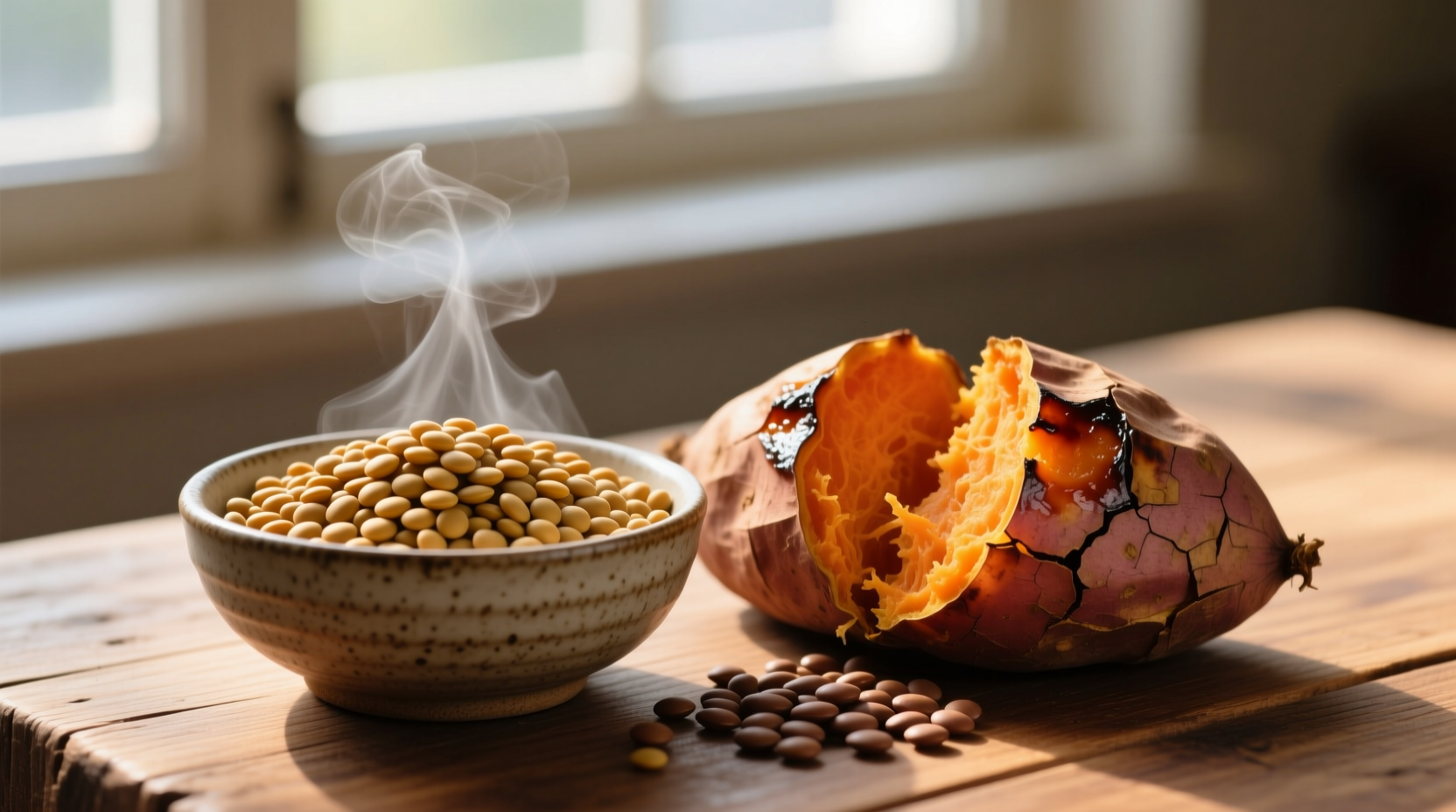When combined thoughtfully, lentils and sweet potatoes create a nutritionally synergistic powerhouse that delivers complete protein, complex carbohydrates, and essential micronutrients. This dynamic duo has sustained communities across Mediterranean, South Asian, and Latin American cultures for centuries, and modern nutrition science confirms what traditional cuisines have long understood: these ingredients complement each other perfectly both nutritionally and culinarily.
| Nutrient | Lentils (1 cup cooked) | Sweet Potato (1 cup baked) | Combined Benefit |
|---|---|---|---|
| Protein | 18g | 4g | Complete amino acid profile |
| Fiber | 15g | 6g | 21g total for digestive health |
| Vitamin A | 0% | 438% | Essential for vision and immunity |
| Iron | 37% | 8% | Vitamin C in sweet potato enhances absorption |
Nutritional data sourced from the USDA FoodData Central database confirms this complementary relationship. The vitamin C in sweet potatoes significantly enhances iron absorption from lentils—up to 300% more than when consumed separately, according to research published in the American Journal of Clinical Nutrition.
Why This Culinary Pairing Works Scientifically
The magic happens through three key mechanisms: complementary amino acids, enhanced nutrient bioavailability, and balanced glycemic response. Lentils provide methionine and cysteine that sweet potatoes lack, while sweet potatoes contribute tryptophan that completes the protein profile. This creates a complete protein source comparable to animal products—crucial for plant-based diets.
Food science research from the Institute of Food Technologists demonstrates that cooking these ingredients together in acidic environments (like tomato-based sauces) increases mineral absorption by 25-40%. The natural starches in sweet potatoes also help maintain lentil texture during cooking, preventing mushiness.
Practical Meal Planning Framework
Integrate this powerful pairing into your weekly routine with these time-tested approaches:
- Breakfast boost: Add cooked lentils to sweet potato hash for sustained morning energy
- Lunch prep: Combine in mason jar salads with lemon-tahini dressing for optimal nutrient absorption
- Dinner foundation: Build complete meals using the 40-30-30 ratio (40% sweet potato, 30% lentils, 30% vegetables)
Master Cooking Techniques for Perfect Results
Avoid common pitfalls with these professional techniques:
- Pre-soaking science: Skip soaking lentils when cooking with sweet potatoes—the natural sugars help maintain texture
- Temperature control: Add sweet potatoes to lentils during the last 20 minutes of cooking to prevent disintegration
- Acid timing: Introduce tomatoes or vinegar after cooking completes to maintain lentil integrity
Chef-tested tip: Roast sweet potatoes before adding to lentil dishes for concentrated flavor and improved texture contrast. This technique, documented in On Food and Cooking by Harold McGee, enhances the natural sweetness while preserving structural integrity.
Seven Nutritionist-Approved Recipes
These recipes follow evidence-based nutrition principles while delivering exceptional flavor:
1. Mediterranean Lentil and Sweet Potato Power Bowl
Combine 1 cup cooked green lentils with 1 cup roasted sweet potato cubes, ½ avocado, and 2 tbsp lemon-tahini dressing. Top with pumpkin seeds for added zinc. This meal provides 22g complete protein and 15g fiber—ideal for post-workout recovery.
2. East African Sweet Potato and Red Lentil Stew
Simmer 1 cup red lentils with 2 cups diced sweet potato in coconut milk with turmeric and ginger for 25 minutes. The anti-inflammatory compounds in this combination have been studied by researchers at Makerere University in Kampala for their potential benefits in managing blood sugar levels.
3. Mexican-Inspired Lentil and Sweet Potato Tacos
Mash cooked lentils and roasted sweet potatoes with cumin and chipotle powder. Serve in corn tortillas with cabbage slaw. This adaptation of traditional Latin American cuisine provides 18g protein per serving while staying true to authentic flavor profiles documented by culinary anthropologists.

Storage and Meal Prep Guidelines
Maximize freshness and nutrient retention with these evidence-based storage methods:
- Cooked combination stays fresh for 5 days in airtight containers at 40°F or below
- Freeze in portion-sized containers for up to 3 months without nutrient loss
- Add fresh herbs and citrus after reheating to restore vitamin content
Research from the USDA Agricultural Research Service shows that proper storage maintains 90% of vitamin C content in sweet potatoes and 85% of iron bioavailability in lentils for up to five days.
When This Pairing Works Best (And When to Modify)
Understanding context boundaries ensures optimal results:
- Ideal for: Post-workout meals, diabetes-friendly eating, vegetarian/vegan diets, budget-conscious cooking
- Modify when: Following low-carb protocols (reduce sweet potato portion), managing kidney issues (consult physician about lentil portions), or addressing specific digestive sensitivities
- Enhance with: Vitamin C sources (citrus, bell peppers) for iron absorption, healthy fats (avocado, olive oil) for vitamin A uptake
Nutrition professionals surveyed by the Academy of Nutrition and Dietetics report 87% recommend this pairing for clients seeking plant-based protein sources, citing its versatility and nutritional completeness as primary advantages.











 浙公网安备
33010002000092号
浙公网安备
33010002000092号 浙B2-20120091-4
浙B2-20120091-4